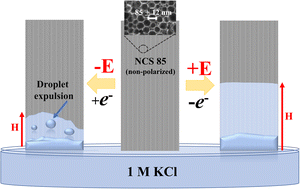Hydrophobic nanoporous carbon scaffolds reveal the origin of polarity-dependent electrocapillary imbibition†
Abstract
An engineered nanoporous carbon scaffold (NCS) consisting of a 3-D interconnected 85 nm nanopore network was used here as a model material to investigate the nanoscale transport of liquids as a function of the polarity and magnitude of an applied potential (‘electro-imbibition’), all in 1 M KCl solution. A camera was used to track both meniscus formation and meniscus jump, front motion dynamics, and droplet expulsion, while also quantifying the electrocapillary imbibition height (H) as a function of the applied potential of the NCS material. Although no imbibition was seen over a wide range of potentials, at positive potentials (+1.2 V vs. the potential of zero charge (pzc)), imbibition was correlated with carbon surface electro-oxidation, as confirmed by both electrochemistry and post-imbibition surface analysis, with gas evolution (O2, CO2) seen visually only after imbibition was well underway. At negative potentials, vigorous hydrogen evolution reaction was observed at the NCS/KCl solution interface, well before imbibition began at −0.5 Vpzc, proposed to be nucleated by an electrical double layer charging-driven meniscus jump, followed by processes such as Marangoni flow, adsorption induced deformation, and hydrogen pressure driven flow. This study improves the understanding of electrocapillary imbibition at the nanoscale, being highly relevant in a wide range of multidisciplinary practical applications, including in energy storage and conversion devices, energy-efficient desalination, and electrical-integrated nanofluidics design.

- This article is part of the themed collections: #MyFirstChemSci 2023 and 2023 Chemical Science Covers


 Please wait while we load your content...
Please wait while we load your content...